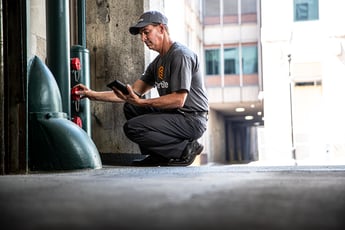
Fire and life safety systems are critical components of all commercial buildings. Though these systems are often taken for granted, it is crucial to make sure they are properly maintained so they work properly in the case of an emergency. To provide a high level of protection, fire and life safety systems need to be inspected per the National Fire Protection Association (NFPA) code schedule and inspections should be conducted by trained professionals.
Inspection schedules vary for each fire and life safety system. The schedules are designed to help identify problems, or deficiencies, with systems so that they can be fixed before there is an emergency. It would be terrible, in the event of an emergency, if the fire sprinkler system was too corroded to effectively extinguish the fire. Your people, assets, and business rely on these inspection cycles for protection.
With an inspection, deficiencies are often identified. Without an inspection, issues can stay hidden and won’t be addressed. A building manager doesn’t want to risk closing the business because a routine inspection wasn’t scheduled and performed. While there are specific guidelines and codes to follow, some are dependent on local jurisdictions so be sure to follow up with your fire and life safety company if you have questions.
Inspection Cycles Overview
With any fire and life safety system, inspections should follow code. There are so many codes out there, your fire and life safety company will know exactly which ones to follow for inspection standards. Some of the common codes are:
- NFPA 25 Standard for the Inspection, Testing, and Maintenance of Water-Based Fire Protection Systems
- NFPA 72 National Fire Alarm and Signaling Code
- NFPA 10 Standard for Portable Fire Extinguishers
- NFPA 17 Standard for Dry Chemical Extinguishing Systems (Paint Spray Booths)
- NFPA 2001 Standard on Clean Agent Fire Extinguishing Systems
- NFPA 17A Standard for Wet Chemical Extinguishing Systems (Kitchen Systems)
Inspection cycles vary by system. They can range from daily and monthly to annual and 5-year cycles. While daily or weekly inspections can be conducted by trained building owners, it’s best to leave them, and all inspections, to a fire and life safety company. Let’s take a look at some of the most common life safety systems.
Fire Alarm Inspection Cycles
There are many types of fire alarm systems each with a variety of components. Regardless of the type of fire alarm system, each of these components require different inspection cycles. Some fire alarms systems interact with other fire and life safety systems throughout the building so it's important to have the inspections performed according to the schedules. Below is a brief overview of some of the inspection cycles for different fire alarm components.
- Daily/Weekly: control panel
- Monthly: automatic fire alarm systems (control equipment)
- Semi-Annually: batteries, initiating devices
Sprinkler Systems Inspection Cycles
Fire sprinkler systems consist of many parts, so it’s critical it have professionals inspect these systems. Their multiple parts should be inspected at least four times per year to ensure they will perform as expected during a fire. The fire and life safety professional will make sure there is no corrosion and that all parts are in their correct positions, properly sealed, accessible, no leakage, and more. Take a look below at the brief overview of what some of the important inspection aspects are for fire sprinkler systems.
- Daily/weekly: gauges, cold weather enclosures, valves, valve components, trim inspections, backflow prevention assemblies, standpipe
- Monthly: gauges, valves, valve components, trim inspections, fire pump system, backflow prevention assemblies, standpipe
- Quarterly: alarm devices, fire department connections, pressure reducing and relief values, hose connections
- Annually: standpipe, valves, valve components, trim inspections, private fire service
- 5-Year Cycle: internal obstruction investigation, valves, valve components trim inspections
Hood Suppression Systems Inspection Cycles
Do you run a kitchen? Then pay attention to this. Preventing kitchen fires is something that needs to be prioritized. Regular inspections help ensure kitchen fires are extinguished. They also make certain the system is in working order.
- Monthly: owner’s inspections
- Semi-annually: suppression system
Portable Fire Extinguishers Inspection Cycles
When you hear fire safety, you probably think of a portable fire extinguisher. In the event of a fire, this is typically the first line of defense so it’s critical to have these inspected annually, but visually inspected monthly.
- Monthly: HMSI label, location, no obstruction to access, safety seals not broken, no physical damage, corrosion, leakage
- Annually: everything with monthly inspection, conductivity test, hanger/seismic bracing, determine 6-year or hydrotest, inspect shell and nameplate
Clean Agent Suppression Systems Inspection Cycles
Clean agent systems need to be inspected or they can malfunction. Containers used to store the fire-suppression chemicals can leak and, if left unchecked for too long, can be empty and ineffective when a fire does occur. Also, hoses used in the system can become damaged, or dispensing nozzles used to keep the system from moving can become loose. Below is brief overview of when and what should be inspected by a trained fire and life safety professional.
- Semi-annually: visually inspect all field devices
- Annually: inspect enclosure
- 5-Year: visually inspect agent cylinders per Cga-C6
Emergency Lights/Exit Signs Inspection Cycles
Emergency lighting fixtures and exit signs need to be inspected regularly in addition to annually. These fire and life safety products often become damaged over time, removable sections can fall off, or they can easily become blocked by something. By performing daily checks, you ensure these systems are clear and performing as they should. These fixtures also require adequate illumination levels even during non-emergency situations so it's important to inspect in and around the fixtures so in the event of an emergency, they can be seen from near and far.
- Monthly: 30-second quick check and battery check
- Annually: 90 minute check
There are many moving pieces to ensure your fire and life safety systems are in top-notch working order. While some of the daily inspections can be performed by the building manager, a trained professional from a fire and life safety company should conduct the others.
Safety is not something you want to mess with, so don’t delay your fire and life safety inspections. Inspections help keep your most important assets safe – your building and the people who work inside.




